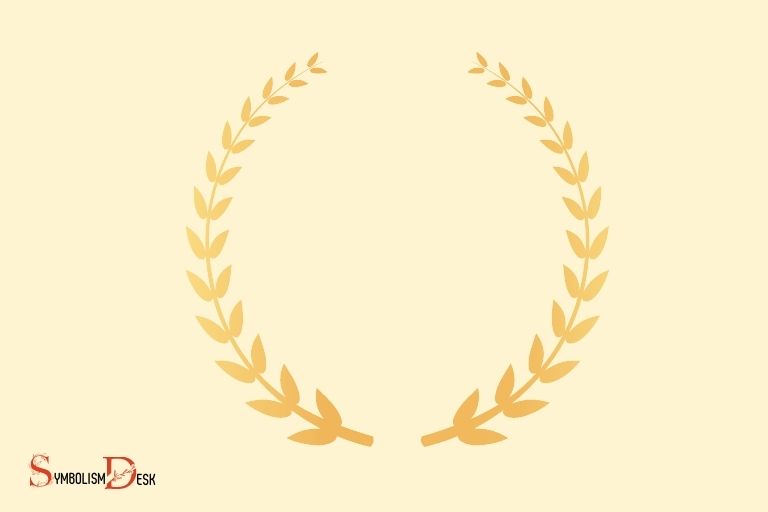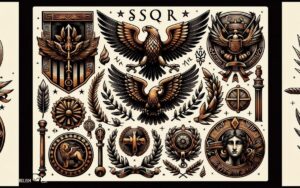Heraldry Symbols And What They Mean? Emblematic Designs!
Heraldry symbols are emblematic designs and figures used in coats of arms, shields, and family crests, telling a story about the history, achievements, and traits of the bearer.
They take various forms, including animals, objects, and colors, each carrying a specific meaning.
For example, a lion in heraldry often symbolizes bravery and nobility, while the color blue (azure) represents truth and loyalty.
Heraldry originated in the High Middle Ages, providing a means of identification in battle and later, a way of establishing and conveying family lineage and status.
The symbols chosen typically held profound significance to the individual or family, representing their values, accomplishments, or characteristics.
This art of heraldry is still in use today, and understanding these symbols helps unravel the rich tapestry of our past.
Heraldry symbols are rich in history and symbolism, playing crucial roles in genealogy, history, and art over the centuries.
They provide an intriguing glimpse into the past, helping us understand the values and aspirations of our ancestors.
Whether you’re researching family history or simply appreciate the artistry of coats of arms, understanding the meaning behind heraldry symbols is undoubtedly fascinating.
16 Heraldry Symbols and Their Meanings
| Symbol | Meaning |
|---|---|
| Lion | Bravery, valor, strength |
| Unicorn | Extreme courage |
| Owl | Wisdom, learning |
| Eagle | Strength, courage, immortality |
| Fleur-de-lis | Purity; light; floral badge of France |
| Dragon | Defender of treasure; valor and protection |
| Griffin | Bravery; vigilance |
| Anchor | Hope, salvation |
| Crown | Authority, leadership |
| Cross | Christian faith |
| Hand | Faith, justice, sincerity |
| Keys | Guardianship, dominion |
| Oak tree | Strength, endurance |
| Phoenix | Resurrection, immortality |
| Rose | Beauty, grace, love |
| Sword | Warlike, martial |
Key Takeaway

Five Facts About: Heraldry Symbols and Their Meanings
A Brief Introduction To Heraldry Symbols And Terminology
Heraldry is an intricate system of symbols and designs that dates back to the middle ages.
It is essentially a way to identify individuals, families, and organizations, and it uses specific imagery to convey specific meanings.
In this section, we’ll provide a brief introduction to heraldry symbols and terminology.
Definition And General Introduction To The Term Heraldry
Heraldry is a system of symbols and designs used to identify individuals, families, and organizations.
A coat of arms is a specific type of heraldic design that typically includes a shield, helmet, and other decorative elements.
Heraldry was originally used to identify knights on the battlefield, but over time it became a way for families to show their status and achievements.
The Origins Of Heraldic Symbols
The origins of heraldry symbols can be traced back to medieval europe. Knights would wear distinctive colors and designs on their armor and shields to differentiate themselves from their foes on the battlefield.
Over time, these designs became more complex and ornate, incorporating animals, plants, and other symbols to represent different characteristics or allegiances.
Brief Terminology And Rules Guiding Heraldic Symbols
Heraldry has a complex set of rules and terminology that governs the design of coats of arms and other heraldic symbols.
Here are some key terms to know:
- Blazon: This is the language used to describe the design of a coat of arms.
- Charge: A charge is any symbol or design element used in a coat of arms.
- Crest: The crest is the decorative element on top of a helmet in a coat of arms.
- Escutcheon: This is another word for shield.
- Supporters: Supporters are the figures (often animals) that appear on either side of a coat of arms.
Additionally, there are strict rules governing the use and design of heraldic symbols.
For example, coats of arms are typically granted by national or royal authorities, and it is considered inappropriate to use someone else’s coat of arms without their permission.
Overall, heraldry symbols and terminology have a rich history and continue to be used today to convey identity and status.
By understanding the key concepts and designs of heraldry, you can appreciate the beauty and complexity of this ancient tradition.
Understanding The History And Evolution Of Heraldry Symbols
An In-Depth Look At The Historical Development Of Heraldry Symbols
Heraldry symbols have a rich history, dating back to the medieval times. Understanding the history and evolution of these symbols is essential in comprehending the meaning behind each symbol.
Here’s an in-depth look at the historical development of heraldry symbols:
- Heraldry symbols originated in the 12th century, when knights began to wear coats of arms displaying unique symbols.
- The symbols were used to identify which knight a soldier was fighting alongside, even when they wore full armor.
- These symbols later evolved to identify noble families, and eventually, individuals.
- The use of heraldry symbols declined in the 17th century with the rise of firearms, which made it easier to identify opponents in battle.
- However, heraldry symbols persisted as a form of identification for noble families and individuals.
How Heraldic Symbols Evolved Over Time
Heraldry symbols have evolved significantly over time. Each period in history has its unique style, with different motifs and symbolic meanings.
Here’s a brief overview of how heraldic symbols have evolved over time:
- Early heraldry symbols were simple, featuring only a few colors and shapes.
- During the 14th century, heraldry symbols became more complex, incorporating a wider range of colors and patterns.
- The 15th century saw an explosion in heraldry symbols’ complexity, featuring intricate designs and motifs.
- By the 16th century, heraldry symbols had become standardized, featuring clear guidelines for creating new symbols.
Key Milestones In The History Of Heraldic Symbols
Heraldry symbols have played a significant role in european history.
Here are some key milestones in the history of heraldic symbols:
- The crusades: During the crusades, knights began to use symbols to identify themselves and their allies, leading to the development of modern heraldry symbols.
- Royal coat of arms: In 1406, king henry iv established the royal coat of arms as a symbol of royal authority.
- The college of arms: In 1484, king richard iii established the college of arms to regulate the use of heraldry symbols and ensure their accuracy.
- The great seal of the united states: In 1782, the great seal of the united states was created, featuring heraldry symbols like the eagle, the stars, and the stripes.
A Brief Overview Of Heraldry Symbol Usage In Current Times
While heraldry symbols are no longer used for their original purpose, they still hold significance in modern times.
Here are some ways heraldry symbols are still used today:
- Personal identity: Heraldry symbols are still used by some individuals as a personal identifier, especially those with noble ancestry.
- Corporate logos: Many companies use heraldry symbols in their logos to signify strength, tradition, and prestige.
- Military insignias: The military still uses heraldry symbols in their insignias, representing the unique identity of their platoons, regiments, and battalions.
- Flags and emblems: Several countries have heraldry symbols in their flags and emblems, representing their national identity and traditions.
The historical development of heraldry symbols has been fascinating, and their evolution has been a symbol of changes occurring throughout history.
While the original purpose of heraldry symbols has diminished, they continue to hold significance in modern times as symbols of personal identity, corporate identity, and national identity.
The Meanings Behind Popular Heraldry Symbols And Devices
Heraldry Symbols And What They Mean
Heraldry, the study of coats of arms and related emblems, was used in the past to identify people and demonstrate power of dynasty, kingdom, or region.
But have you ever wondered about the meanings behind the different symbols and devices?
Let’s delve deeper and find out.
The Significance Of Different Colors In Heraldic Symbols:
- Different colors used in heraldic symbols are known as tinctures. Each color holds its own meaning and significance in heraldry.
- Red signifies bravery and fortitude; blue symbolizes loyalty and truth; green represents hope and joy; black stands for determination and sophistication; white denotes purity and innocence, and gold or yellow signifies generosity and elevation of spirit.
- The combination of these colors and variations of shades can convey other meanings too. For instance, a light blue represents serenity and peace whereas a deep blue is associated with wisdom.
- The use of colors can also indicate the geographical area, family alliance or rank, occupation and even personality traits.
The Meanings Behind Popular Symbols Like Lions, Eagles, And Dragons:
- A lion is one of the most common heraldic symbols that represents courage, strength, and leadership. It’s usually depicted standing on its hind legs.
- Eagles are often used in heraldry to signify nobility, vision, and strength. They are often shown with wings spread wide and talons extended.
- Dragons represent a sense of mystery, power, and wisdom. They are the ultimate symbol of strength and fearlessness.
- Other popular symbols include unicorns (representing purity and grace), bears (representing strength and cunning), and wolves (representing bravery).
How Heraldry Symbols Were Created To Capture Specific Attributes Of People, Animals Or Country:
- Heraldry symbols were developed to capture and represent specific traits, values, and aspirations of dynasties, countries, or people.
- Heraldic designs were meant to quickly identify the owner, whether on a battlefield or in a court of law, and signify their power, social status, and lineage.
- This is why the symbols display both animals and plants, they are easily recognizable, but they are also used to display important attributes. For example, an apple tree is used to represent peace.
An Analysis Of The Various Types Of Devices That Are Commonly Used:
- Devices on a coat of arms can indicate the profession, geographical location, or family ties of the owner.
- Charges are a type of device that includes anything from animals and plants to weapons and geometric shapes.
- Crests are another type of device that may appear at the top of a coat of arms, often depicting an animal or other significant image.
- Another common device is a motto, which is a phrase or saying that is often used to express the values or aspiration of the family, country, or region.
By exploring the meanings behind popular heraldry symbols and devices, we can gain a better understanding of the different values and aspirations represented by them.
They are not just random designs but are carefully crafted to represent the ideologies, personalities, and achievements of those they depict.
Decoding And Interpreting Heraldry Symbols
Heraldry symbols are an ancient form of identification and are still in use today. However, for the untrained eye, interpreting the meanings conveyed by these symbols can be quite a challenge.
A heraldic symbol is a representation of a person, family, or country, and decoding its meaning requires knowledge about various aspects.
Here, we’ll look at the different approaches to interpreting heraldry symbols, understand the meaning conveyed by the various colors used, and gain insight into the symbolism behind the placement of devices in heraldic symbols.
Different Approaches To Interpreting Heraldry Symbols
Interpreting heraldry symbols requires an understanding of various aspects, like the time period when the coat of arms was first created, the family’s history, and the region’s history.
Let’s look at the different approaches to interpreting heraldry symbols:
Historical: This involves analyzing the history of the coat of arms, the family, and the region. Historical research will help identify the possible meanings of the symbols and the context in which they were used.
Look for the cultural and historical significance of the symbols in the coat of arms.
Symbolic: Approach the coat of arms like a puzzle, analyze the symbols, colors, animals, and objects, and try to decipher their meaning using a symbolic approach.
For example, a lion might represent strength and courage, while a bear symbolizes bravery.
Blazon: This approach entails describing the coat of arms as per the formal set of rules adopted by the international heraldry society.
Blazoning involves using specific terms to describe the color, shape, and position of the symbols in the coat of arms.
Understand The Meaning Conveyed By The Various Colors Used
Colors play a crucial role in heraldry symbols as every color has a specific meaning.
Here are the most commonly used colors and their meanings in heraldry symbols:
- Red: Bravery, strength, valor, and passion
- Blue: Loyalty, truth, and piety
- Green: Hope, joy, and loyalty in love
- Purple: Royalty, sovereignty, and justice
- Gold: Generosity, elevation of the mind, and wisdom
- Silver/white: Peace, sincerity, purity, and innocence
- Black: Grief, sorrow, and sometimes humor
The Symbolism Behind The Placement Of Devices In Heraldic Symbols
The placement of devices in a coat of arms has significant meaning.
Here’s what each position means:
- Upper dexter (right side of the shield): Honor, highness, and seniority
- Upper sinister (left side of the shield): Dishonor and illegitimacy
- Lower dexter (right side below the middle): Perpetual memory
- Lower sinister (left side below the middle): Mourning and profession of a vow
- Middle chief (top center of the shield): Honor
- Middle base (bottom center of the shield): Hope, or sometimes represents water
- Center of the shield: Represents the strength and heart of the bearer
Overall, understanding heraldry symbols is essential to identify coat of arms and their interpretation.
While there are many different approaches to heraldry symbol interpretation, the meaning conveyed by the colors used and the placement of devices is universal.
So, next time you see a coat of arms, take a moment to analyze its symbols and colors to identify its meaning.
What Does the Lightning Symbol Mean in Heraldry?
The lightning symbol on fitbit indicates battery life. In heraldry, the lightning symbol holds its own significance. It represents power, swiftness, and divine intervention. Often depicted as a zigzag line with pointed ends, it symbolizes the unpredictable and unstoppable force of lightning, capturing attention and conveying energy in heraldic designs.
FAQ About Heraldry Symbols And What They Mean
What Is Heraldry?
Heraldry is a system of identifying individuals and families by using symbols, colors and designs.
What Are Heraldry Symbols?
Heraldry symbols are designs or figures used to represent a person, family or organization.
What Do Heraldry Colors Mean?
Heraldry colors have different meanings. For instance, red represents nobility and blue represents truth and loyalty.
How Do I Identify A Heraldry Symbol?
You can identify a heraldry symbol by analyzing its shape, color and design. Researching its history and meaning can also help.
What Is The History Of Heraldry?
Heraldry evolved in the middle ages as a way to distinguish knights in battle. It became a status symbol for the nobility.
Conclusion
After delving into the fascinating world of heraldry symbols, it’s clear that each emblem is unique and tells a story about the family or organization it represents.
Some symbols represent power and strength, while others represent nobility or creativity. The use of colors and shapes adds another layer of symbolism to the design.
Understanding the meaning behind these symbols can give us a glimpse into the history and values of those who used them. Understanding the meaning behind these symbols can give us a glimpse into the history and values of those who used them. For example, examining ancient markings can reveal insights into cultural beliefs or warnings they deemed important to communicate. Similarly, modern hazard symbols explained simply are designed to ensure safety and clarity, making it easier for people to quickly grasp potential risks in everyday environments. This shared visual language connects practicality with the responsibility of protecting lives.
Beyond their historical significance, heraldry symbols are still used today in government, military, and social organizations to represent an entity’s identity.
The importance of heraldry symbols cannot be overstated, as they serve as a tangible reminder of the past and present.
By studying and appreciating these symbols, we can gain a better understanding of the stories and values that have shaped our world.






